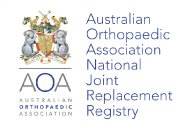Background
Background
Joint replacement is a commonly performed major operation that has considerable success in alleviating pain and disability. The rate of joint replacement surgery has been increasing at a rapid rate for many years. It is anticipated that it will continue to do so. Currently more than 85,000 hip and knee replacements are undertaken each year in Australia.
The outcomes of joint replacement are variable. There are many factors known to influence this. Age, gender and diagnosis of patients, the type of prosthesis and the surgical techniques used are just some of these. Superimposed on this, is the rapid rate of change in medical technology. There is continual development and use of new types of prostheses and surgical techniques, the results for many of which remain uncertain.
The Australian Orthopaedic Association recognised the need to establish a National joint replacement registry in 1993. At that time, the outcomes of this surgery in Australia were unknown. It was unclear who was receiving joint replacement or the types of prostheses and techniques being used to implant them. The need to establish a registry was in part based on the documented success of a number of arthroplasty registries in other countries, in particular the Swedish Arthroplasty Registries. The ability to identify factors important in achieving successful outcomes had resulted in both improved standards and significant cost savings.
In 1998 the Commonwealth Department of Health agreed to fund the Australian Orthopaedic Association to establish the AOANJRR. The AOANJRR began data collection in South Australia on 1 September 1999 followed by a staged implementation in each of the Australian states and territories becoming fully national during 2002. In 2007, the AOANJRR expanded its data collection to include shoulder, elbow, wrist, ankle and spinal disc replacement. This was fully implemented in November 2007 with all hospitals undertaking joint replacement in Australia approving participation of the additional data collection.
The Commonwealth Department of Health continues to fund the AOANJRR. In June 2009, legislation was passed that enables the Commonwealth to cost recover the funding thus ensuring the longevity of financial support to the AOANJRR.
The purpose of the AOANJRR is to define, improve and maintain the quality of care of individuals receiving joint replacement surgery. It achieves this by collecting a defined minimum data set that enables outcomes to be determined on the basis of patient characteristics, prosthesis type and features, method of prosthesis fixation and surgical technique used. The principal measure of outcome is revision surgery. It is an unambiguous measure of the need for further intervention. Combined with a careful analysis of the timing and reasons for revision this can be used as an accurate measure of the success or otherwise of a procedure. The AOANJRR also monitors mortality rates. This information is then used to inform surgeons, other health care professionals, governments, orthopaedic companies and the community.
Although the AOANJRR has only been in existence and fully operational for a relatively short time the continual monitoring process inherent in the AOANJRR's function has established that information provided by the AOANJRR is already influencing joint replacement in a beneficial manner. The major benefit from the AOANJRR however will not be achieved until longer-term outcomes can be established.
